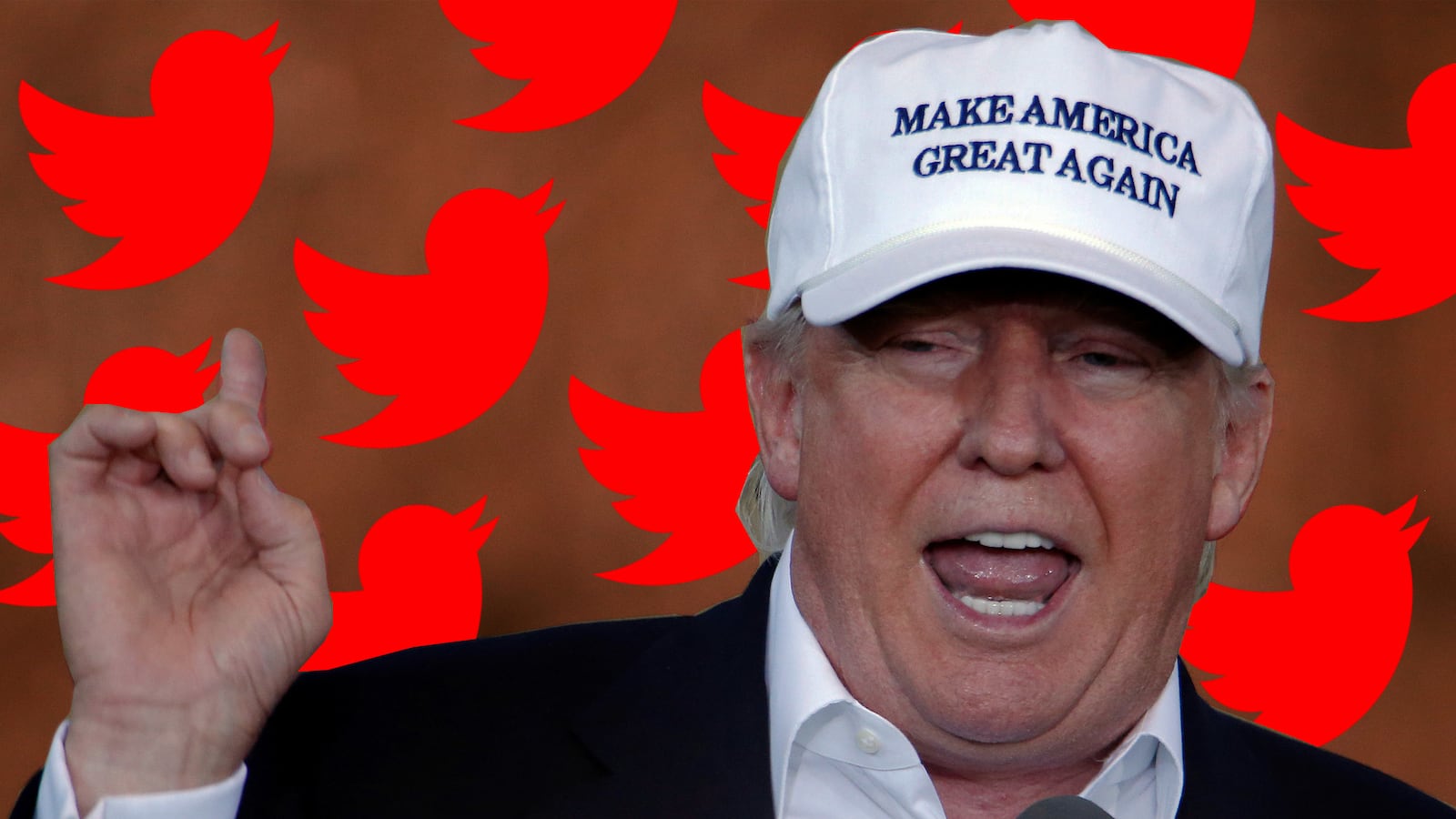Has there been a more feckless, disconnected and intellectually lazy major party nominee for president in the modern era? By any measure, the answer is no.
Donald Trump, a man known for hurling racially-charged brickbats of intolerance, spent recent days spewing vile stereotypes in a ham-fisted attempt to appear more sympathetic to African-American voters and blaming Democrats for the social maladies that tend to plague many of nation’s largest cities.
But, Saturday morning, in a uniquely craven and breathtakingly vulturistic social media post, Trump proved—once again—that he knows no boundaries.
Linking the shooting death of NBA superstar Dwyane Wade’s cousin to his own recent rhetorical flourishes about so-called black-on-black crime, the former real estate developer seemed to say: I told you so.
“Dwyane Wade’s cousin was just shot and killed walking her baby in Chicago,” Trump said, in a tweet he deleted, then reposted with the correct spelling of the NBA star’s name. “Just what I have been saying. African-Americans will VOTE TRUMP!”
The fact that the onetime reality television personality originally misspelled Wade’s first name, did not mention Nykea Aldridge by name and failed to extend condolences to the family was largely greeted with derision. As the nation grapples with meaningful solutions to some of our most pressing dilemmas—including how to stem the tide of gun violence—and a family was dealing with a tragic loss, Trump was taking a victory lap.
The 32-year-old mother, on her way to enroll her children in school, was pushing her youngest child in a stroller this Friday when two men approached her and another man on the street. Caught in the crossfire, Aldridge was struck in the head and arm. Police say she was not the intended target. The mother of four was pronounced dead at Cook County’s Stroger Hospital.
Trump, who appears to get his sketchy public policy ideas from tooling around fringe websites, immediately pounced on the horrific incident as proof that he deserves more support from black voters. In recent days, Trump has attempted to parlay his feigned benevolence for social disparities in predominantly non-white, inner-city neighborhoods into political gains among white suburbanites. His ripped-from-the-headlines message may have won Trump a fractured Republican primary. But, over time, his off-the-cuff and sometimes scripted remarks have proven costly—to both himself and the broader GOP. Party insiders see him as a wrecking ball, concerned more with his own cheering crowds of true believers than building the kind of broad coalition of support that could win him the presidency and help down-ticket candidates.
For its part, the Republican National Committee conducted an “autopsy” in 2012 that was supposed to serve as a framework for minority outreach. Now, however, Trump, appears to be kicking the body.
Trump and his advisers, including newly installed campaign chief executive Stephen Bannon, have peddled the notion that Democrats are solely responsible for the breakdown of American cities. They point to Chicago, Baltimore and Detroit—like boogeymen—then protest that poverty and violent crime are the result of liberal, big-government policies. They say this as if conservatives, both Republicans and the conservative Democrats who fled the GOP, are not themselves to blame.
It is not as if Trump has no access to economic analysis, stratified by race. It is not as if the legacy of Jim Crow, including racial division codified in law and economic self-segregation, are a mystery. He need only skim the pages of Isabella Wilkinson’s book The Warmth of Other Suns or Doug Blackmon’s Slavery By Any Other Name for some of the answers. “The Case for Reparations,” a long-form article by Ta-Nehisi Coates for The Atlantic, would be a good start.
Few notions in the discourse are quite as mendacious as the myth the Democrats destroyed some of the nation’s largest, predominantly black cities. One does not have to peel open a history book or even go digging in the bowels of a library archive to understand how decaying inner-city neighborhoods were created. Then too, today the poorest, most welfare-dependent states are in the South—and all of them are led by Republican governors.
It was conservatives who created so-called “sundown” towns, whole municipalities that were manufactured out of whole cloth as all-white enclaves. The worked to keep black people trapped inside cratered inner-city economies.
Driven by black migration from the South and white resistance to civil rights, white flight began around the turn of the century and escalated after WWII. Housing and job discrimination, which continues into the present day, contribute mightily to destroying tax bases and the physical infrastructure. The fleeing factories left behind toxic waste that later pervaded the air, water, and soil in places like Flint, Michigan, and East St. Louis, Illinois—where the adult morbidity and infant mortality rates among black people now spell out a national shame.
Former smokestack cities, like Kansas City, Missouri, and Gary, Indiana—once economic boom towns—saw manufacturing and other meaningful jobs stripped out of their core and moved to the suburbs. Even the nation’s interstate highway system was built to aid the mobility of suburban whites and cut right through predominantly black neighborhoods. The eroding tax bases they left behind resulted in crumbling schools, failing public health services and other broken institutions—and none of it was unintentional.
They dosed inner cities in gasoline, struck a match and ran. They left those communities—and the people who lived there—to burn, and then blamed the new elected officials—most of them Democrats—for the fire. The gun to Aldridge’s head wasn’t cocked last Friday. That bullet was fired decades ago, when self-segregation became a way of life.
“Smaller government” and “local control” have become buzzwords for “don’t use my tax dollars to support them.” And by “them,” they mean black people.
For example, in places like Birmingham and Memphis, where black children began going to school with white children, local governments simply redrew the lines or formed their own school districts to keep black families out. That is not simply a snatch of old history. It is still happening in places like Gardendale, Alabama—a Birmingham suburb—in 2016 and supported by so-called Republican principles.
The economic power obtained through legalized discrimination, from slavery through Jim Crow, was harnessed and used to maintain it long after the laws had been erased from the books. Violence, generational poverty, environmental injustice and other pathologies are the result.
American ghettos were created by the very conservative principles being touted today. But they take no blame and harbor no shame for the fire no one—Democrat or Republican, liberal or conservative—has the political will to stamp out.
While it is doubtful that Trump has studied that history, he has picked up and embraced its torch.
“You walk down the street and you get shot!” Trump has exclaimed before audiences, in city after city. “You get shot!”
Apparently oblivious to the significant social and economic gains of the black community, not to mention the increasing number of college-educated African Americans who populate both cities and suburbs, Trump eschews the confines of issue analysis and policy proposals shaped by the cold, hard facts of history.
Instead, he has become a pitchman for an ugly ideology better suited for a political graveyard. He has never once hosted an event in a predominantly black space—if you don’t count his rally at the largely white University of Chicago on the city’s predominantly black south side—or addressed a black audience. Rather, Trump has taken his message of inclusion to the suburbs where he has regaled white audiences with his mendacity and bombast.
He cannot help himself and there will be no “pivot.”
There will be no broad swing toward reasonable and well-formed policy solutions and, despite the best hopes and wishes of right-leaning political prognosticators, the cavalry is not coming. Those who do have the depth of experience to save his fledging campaign (not to mention deep-pocketed donors) have long since run for the hills, afraid of handing their necks over to the albatross. The staff that remains is replete with know-nothing, say-nothing sycophants and grifters who seem more interested in cable news airtime and a paycheck.
There is frankly no one around who can or will pull Trump’s proverbial custom tailored coattail. There is no one who can or will say, “Enough is enough.” Whether haplessly or helplessly, they gather about and applaud his unchecked bigotry on demand.
That Trump would now point to the death of a young black woman as evidence of his prescience and political efficacy should come as no surprise. After all, his answer to everything seems to be: Send the police.
There is apparently no gatepost for his bigotry. If he has a moral center, it is not readily evident. For a man who claims he loves America, Trump has spent precious little time getting to know her.





